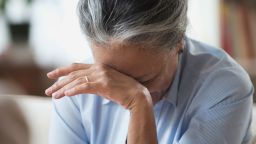CNN
—
Loss of slow-wave sleep as you age may increase your risk of developing dementia, according to a new study.
“We found that aging was associated with a decline in the amount
of the deepest stages of sleep, known as slow wave sleep,” said Matthew
P. Pase, senior author of the study published Monday in the journal JAMA Neurology, via email. Pase is an associate professor of psychology and neurology at Monash University in Australia.
“We then found that persons with greater declines in slow wave
sleep over time had a higher risk of getting dementia over the next 17
years of follow-up,” said Pase via email.
Slow-wave sleep
is the third stage of sleep, which is important for brain health.
During this stage, the body removes unwanted, or potentially harmful,
materials from the brain — including beta-amyloid protein, a hallmark
sign of Alzheimer’s disease.
For the brain, this deep sleep is thought to be the most
restorative, said Dr. Richard Isaacson, director of research at the
Institute for Neurodegenerative Diseases in Florida, via email. Isaacson
wasn’t involved in the study.
The authors wanted to know whether chronic reductions in slow-wave
sleep over time are linked with dementia risk in humans and vice versa —
whether dementia-related processes in the brain may contribute to
getting less of this type of sleep.
“Results suggest that chronic declines in slow wave sleep, rather
than individual differences at any given time, are important for
predicting dementia risk.” Pase said.
The researchers studied 346 people who were age 69 on average and
had participated in the Framingham Heart Study and completed two
overnight sleep studies — one between 1995 to 1998 and the second
between 1998 to 2001 — during which their sleep was monitored. Launched
by the US National Heart, Lung and Blood Institute in 1948, the Framingham Heart Study identifies common factors contributing to cardiovascular disease.
The authors also investigated whether any changes in the amount of
slow-wave sleep that participants got was associated with developing
dementia up to 17 years after they completed the sleep studies.
By that time, 52 participants had been diagnosed with dementia.
Each percentage decrease in slow-wave sleep per year was linked with a
27% increased risk of developing dementia and a 32% higher risk of
Alzheimer’s disease dementia. The rate of slow-wave sleep loss
accelerated from age 60, peaked from ages 75 to 80 and slowed afterward.
Those who experienced declines in this deep sleep were more likely
to have cardiovascular disease, take medications that affect sleep and
carry a gene that makes people more at risk for Alzheimer’s (the APOE ε4
allele).
“This is an important study yet again showing the impact of
quality of sleep on a person’s risk of cognitive decline and dementia,”
Isaacson said. “It’s important to not only pay attention to the total
amount a person is sleeping each night, but also monitor sleep quality
as best as possible.”
Deep sleep and dementia
The study isn’t the first to find such connections — in a May study, every 10% decrease in deep sleep meant an increase in damage to tissues that form connections between brain cells.
But the latest research still doesn’t prove that loss of slow-wave
sleep causes dementia, the authors said, and it’s also possible that
dementia-related processes occurring in the brain could lead to the
sleep loss — a process one expert called a “vicious cycle.”
“The accumulation of amyloid beta in the brain can interfere with
how much we sleep, especially as we age,” said Dr. Rudolph Tanzi,
director of the Genetics and Aging Research Unit at Massachusetts
General Hospital, via email. Tanzi wasn’t involved in the study.
“As a result, by not getting enough slow wave sleep, less amyloid
is cleared, then leading to a vicious cycle of Alzheimer’s pathology,”
he added via email. “Thus, safe drugs aimed at lowering production of
amyloid will be important.”
Pase’s advised people to prioritize getting good sleep. “Good
quality sleep is important for many aspects of health and may also help
to protect the brain as we age,” he said. “Persons experiencing sleep
problems can consult with their doctor to discuss tailored solutions.”
If deep sleep “does turn out to be a proven modifiable risk factor
for Alzheimer’s and dementia, then we need to empower people to be able
to track and monitor (their sleep) more closely,” Isaacson said.
For this purpose, he recommended wearing tracking devices that can
monitor your time in bed, time asleep and time spent in each sleep
stage.
These devices aren’t perfect, he cautioned, but “they can at least
give people at risk, and their physicians, real-time information that
can be acted upon.”
Adopting a few healthy habits — another thing tracking devices
would be able to indicate the effectiveness of — may also help protect
your sleep and brain health.
“Exercise on a regular basis helps ‘loosen up’ the bad
(disease-causing) proteins — called amyloid — from brain cells, and
adequate deep sleep is necessary at night to ‘take out’ the amyloid
trash,” Isaacson said.
Limiting alcohol and caffeine before bed, and ensuring you get
seven to nine hours of sleep at the same time each night, can help
improve sleep quality.






![[Photos] 27+ Rare Photos Show The Darker Side Of The Wild West](https://shftr.adnxs.net/r?url=https%3A%2F%2Fimages.mediago.io%2FML%2F691cea5d7502f219c3df9b682d4786f4__scv1__300x225.png&width=152&height=114&crop=1&bidder=529&buying_member=13368&selling_member=280&creative_id=426682271)